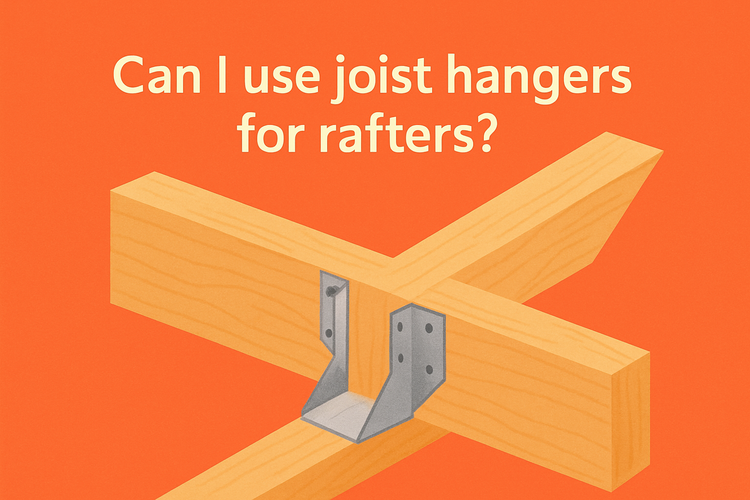Can I Use Joist Hangers For Rafters

Can Joist Hangers Be Used for Rafters?
Yes, joist hangers can be used for rafters, but with certain conditions. Structural integrity, load capacity, and rafter orientation all influence whether joist hangers are suitable.
Joist hangers are versatile connectors designed to carry loads in timber-to-timber or timber-to-masonry applications. Provided the rafters are seated properly and the design meets building regulations, joist hangers can be an effective and secure solution for fastening rafters to beams or walls. Always ensure compatibility between the hanger type and timber dimensions to maximise safety and support.
Understanding the Load and Orientation
Before using joist hangers for rafters, it's critical to assess the expected load and installation orientation. Rafters are structural components that transfer roof loads to load-bearing walls, and incorrect anchoring may lead to structural failure.
Joist hangers are primarily designed to support vertical loads. However, rafters introduce angled and sometimes lateral forces, especially when used in roof structures with high pitch. When selecting joist hangers, opt for those that can resist these multi-directional forces. Reinforced or skewed-angle joist hangers are particularly suited for specific rafter angles, ensuring proper alignment and support under dynamic stress. For roof applications that require additional stability, you might also consider integrating roof connectors to enhance the system's overall strength and weather resistance.
The direction of load transfer is another factor. Rafters exert a combination of vertical and horizontal forces, so joist hangers must be installed precisely to accommodate this pattern. Local building codes and guidelines from structural engineers often provide specifications on acceptable hanger types and load thresholds. By adhering to these, homeowners and builders can confidently incorporate joist hangers into roofing frameworks without compromising safety or function.
Choosing the Right Type of Joist Hanger
Not every joist hanger is suited for rafter installation. Selecting the appropriate model is paramount to ensuring stability and long-lasting performance.
Heavy-duty joist hangers made from galvanised steel or stainless steel are generally recommended for rafter-to-beam connections in outdoor installations or high-load scenarios. These hangers resist corrosion and are built to handle varying load directions. Look for models that provide full-wrap or extended side flanges for extra bearing area, especially where the rafter cuts at an angle.
Some rafters may not sit flush with beams or walls and require specialised skewed or sloped seat hangers. These are designed to match the slope of the rafter, allowing for improved contact and load transfer. Products within the joist hangers category offer several configurations to match such requirements, including concealed flange versions for aesthetic finishes or stronger surface plates for industrial use.
Be cautious of using joist hangers beyond their rated limits. Misapplication leads to reduced holding force, possible warping, or even structural damage. To ensure secure installations, always verify the load ratings of the hanger against your roofing design's requirements.
Installation Best Practices for Rafters
Proper installation of joist hangers for rafters is just as crucial as selecting the right hanger type. Incorrect installation could undermine the entire structural integrity of the roof.
An important rule is to ensure the hanger sits level and centred on the structural support member before fixing any fasteners. Use nails or screws specified by the hanger manufacturer—substituting incorrect fasteners lowers strength and invalidates warranties. Always drive connectors fully, ensuring there are no gaps between the hanger and timber surface.
Additionally, when installing joist hangers for rafters, use a consistent layout. Spacing should be measured carefully, and hangers must be fixed into solid timber or masonry. In cases where rafters are attached to a lateral load-bearing frame or high wind zones, installers are advised to reinforce the setup using high wind ties & timber connectors. These supplemental components provide extra rigidity and protection from uplift forces during storms or heavy weather conditions.
If in doubt, consult a structural engineer or follow specific guidelines provided by joist hanger manufacturers to avoid compromising building regulations or safety standards.
Benefits and Limitations of Joist Hangers for Rafters
Using joist hangers for rafters comes with several advantages, including enhanced ease of installation and strong load-bearing capabilities. However, some limitations also exist depending on your application.
The key benefit is that joist hangers make constructing pitched roofs and complex joins far simpler. They allow for prefabrication, quicker assembly on-site and align with high accuracy. When rafters are modified to non-standard angles or carry increased loads, joist hangers offer modularity and flexibility with minimal field adjustments. This reduces downtime and ensures consistency across builds.
Despite their strengths, joist hangers may not be appropriate for all conditions. They depend on correct installation and full support from surrounding framework. In older or uneven structures, relying solely on joist hangers may not yield sufficient performance. Supplementary brackets or post bases might be needed to redistribute loads.
Overall, joist hangers are compatible with rafter installation under specific circumstances. For optimal performance and safety, ensure your choice is rated for roofing applications and paired with necessary support connectors where appropriate.
